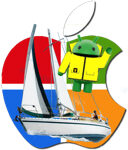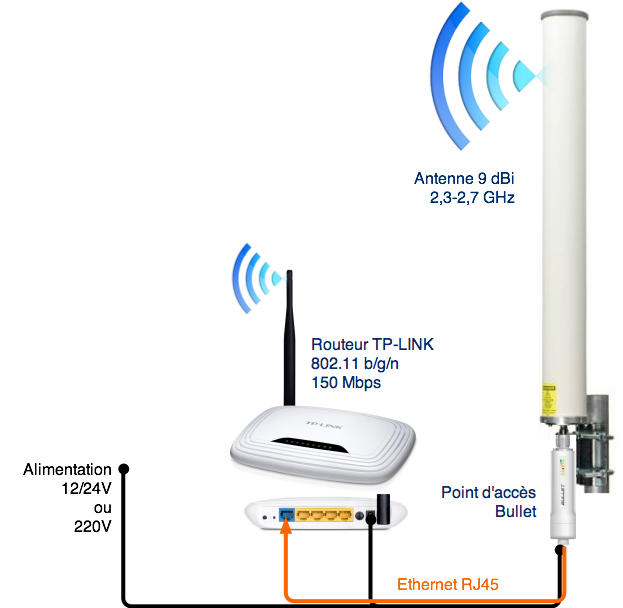Request more frequent from boat owners is for the installation of a WiFi reception onboard. The proliferation of computers, tablets and smartphones on boats incentive to maintain a connection with the Internet, even while sailing. Exchange emails, Follow social media, Receive weather files, and how many other reasons lead to an irrepressible addiction. C’est la vie !
I have already mentioned on my website, in chapter about means for receiving GRIB files, some available solutions :
- You can choose an active amplified reception antenna, like the WAVERV by RadioLabs, distributed in France. Well known as excellent, it is provided with a direct USB connection. But the cable length is therefore limited for reasons of online loss, and requires the installation of a driver Realtek no longer updated for Mac OS since 10.6. In addition, it is provided to connect to a single computer. So it's a simple but limited solution.
 The other option is to choose a reception antenna doubled by an access point, with Ethernet connection. No more distance limit for the Ethernet cable, and the possibility of connecting it to a LAN router (Local network) and WiFi provides a real solution to shared network onboard. I reported the model Bullet which is now part of a kit available in France.
The other option is to choose a reception antenna doubled by an access point, with Ethernet connection. No more distance limit for the Ethernet cable, and the possibility of connecting it to a LAN router (Local network) and WiFi provides a real solution to shared network onboard. I reported the model Bullet which is now part of a kit available in France.
Shared WiFi access kit
The online store iTabNav.fr offers since a few days a complete kit for WiFi reception on board and installing an access point available to all devices in the boat.
- An omnidirectional antenna by Mars Antennas Ma-wo25-9 to 9 dBi (¹) and a vertical angle of 10 °. This fairly imposing antenna of 67 cm high is supplied with a tube fixing support (pulpit, stern hoist). It is sealed to IP65 and guaranted to resist 110 knots wind.
- An Ubiquiti access point Bullet WiFi 802.11b/g with Ethernet interface, fixed under the antenna with waterproof N-plug connector. Alimentation PoE 12 to 24V power with Ethernet cable. Operating temperature from -20 ° C to +70 ° C. Comes preconfigured to connect to public hotspots. All settings can be modified by a web interface accessible from any mac browser, PC or iPad.
- A LAN+WIFI router TP-LINK 150 Mbps 802.11/B/G/N with a WAN RJ45 connector, 4 LAN RJ45 connectors and a WiFi antenna 5 dBi. The router allows simultaneous access of several devices on the Internet received by the antenna. In the absence of internet reception, The router allows exchanges between the different connected devices, eg. exchange of files between a PC and an iPad with Files Connect application.
For a price less than 260 €, It is a complete kit preconfigured and easy to install. We will see in a future entry that the router can also be used as a gateway to deport the screen of an iPad to a computer screen. Stay connected !
—
(¹) dbi = isotropic decibel. Winning unit, Passive amplification power, antenna.
—



Bonjour,je viens d’acheter ce produit mais je voudrais savoir si l’antenne installée sur un portique mais assez près du tube a une influence sur la réception l’antenne etant omnidirectionnel.
merci de me répondre
cordialement
No, A stainless steel tube is an inert material that has no influence on the spread of this type of wave.
I discover this article right now, And precisely during the past weeks I did multiple WiFi installation tests : Omnidirectional antenna 8.5DBI, Direction antenna 19DBI, WiFi receiver with super sensitivity, aso, aso.
On paper, WiFi seems much better than 3G. But in practice, We realize several negative points :
– Most WiFi access points are boxes (livebox, freebox, aso) inside trade-restaurant, and therefore their quality of emission/reception is very poor.
– As the boxes are numerous, It makes a lot of interference and it harms the quality.
– Ports wifi areas generally have a powerful program, A mediocre reception, And the flows are voluntarily restrained.
As a result, 3G is a better solution although not very fast… But it's always much better than wifi.
Here are my little conclusions.
I take any advice on the contrary or advice.
Thank you for this information… This is exactly what I'm looking for!
Sincerely
Pierrick
What about the digital yatch solution that you mentioned in a previous ticket ?
Hello Do you have an idea of the scope of such a system installed on board ? I imagine that it is only usable when you are at the port or anchor. But free access points are sometimes far from our parking point. Hence an interest before making this investment, certainly reasonable, to know its real efficiency. If a test could be done on your side or that of iPadnav, Information could be useful to decide to buy.
Fullhaya
Bonjour,
Unfortunately the scope is not a fixed data. It depends in particular on the material which "emits" the signal, Not to mention obstacles. For example it could be 100 M to connect to a classic interior access point of a restaurant, or 1 km to connect to an efficient external antenna from a well -equipped harbor center. In addition, the range depends on your instant need in terms of flow (Simple email or download for example) which conditions the number of "bars" of signal required.
This kit is in any case a means of obtaining a significant improvement since with an iPad or a PC alone, We know that we capture a signal a few tens of meters at most.
Sincerely
Thank you Francis
For information, We now also offer another kit with a mobile antenna, intended for browsers who do not want (or cannot) Install a meeting antenna.
Dominique